Day 1
ARRIVE ST. PETERSBURG
Day Schedule
➤Meet and greet at the airport
➤Transfer to your hotel and check-in
➤Evening free at leisure
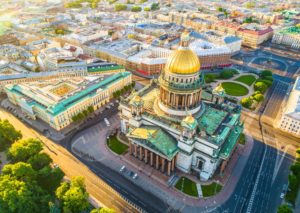
Welcome to St. Petersburg!
Founded by the Tsar Peter the Great on 27 May 1703, St Petersburg was planned and built as the capital of newly emerged Russian Empire. Today, it is arguably one of the most beautiful cities in Europe and UNESCO World Heritage Site.
Immerse yourself deep into rich Russian history, art and culture, Russian Revolution & Romanov Imperial legacy. The White Nights, luminous northern midsummer eves, are the summer weeks when St. Petersburg is sparkling like good champagne.

Your driver will be waiting at the airport/train station to take you to the cozy hotel in the downtown.
For the evening, we suggest to visit oone of famous rooftop restaurants with gorgeous Russian cuisine and amazing views.
Day 2
HISTORY & ART
Day Schedule
➤Breakfast
➤The guided tour to the real warship named “Aurora”
➤The guided tour to the State Russian Museum
➤The evening is free at leisure
We draw your attention that the schedule of the excursions can be changed.
About Aurora
Aurora is a 1900 Russian protected cruiser, currently preserved as a museum ship in Saint Petersburg. Aurora was one of three Pallada-class cruisers, built in Saint Petersburg for service in the Pacific. All three ships of this class served during the Russo-Japanese War. Aurora survived the Battle of Tsushima and was interned under US protection in the Philippines, and eventually returned to the Baltic Fleet.
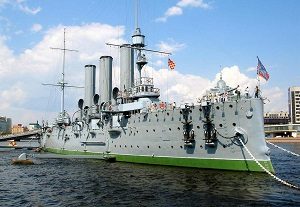
About the State Russian Museum
The State Russian Museum is the world’s largest depository of Russian fine art. It is also one of the largest museums in the country. The museum was established on April 13, 1895, upon enthronement of Nicholas II to commemorate his father, Alexander III. Its original collection was composed of artworks taken from the Hermitage Museum, Alexander Palace, and the Imperial Academy of Arts. After the Russian Revolution of 1917, many private collections were nationalized and relocated to the Russian Museum. These included Kazimir Malevich’s Black Square.
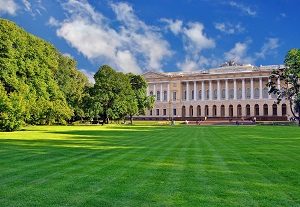
Day 3
CATHERINE’S PALACE & AMBER ROOM
Day Schedule
➤Breakfast
➤The tour to Pushkin/Tsarskoye Selo
➤The Catherine Palace and world-famous Amber Room with the guided tour inside
➤The evening is free at leisure
The Catherine Palace
This stunning Rococo palace located in the town of Tsarskoye Selo (Pushkin), 30 km south of St. Petersburg, was the summer residence of the Russian tsars. The residence originated in 1717 when Catherine I hired German architect Johann-Friedrich Braunstein to construct a summer palace for her pleasure. Construction lasted for four years, and on 30 July 1756 the architect presented the brand-new 325-meter-long palace to the Empress.
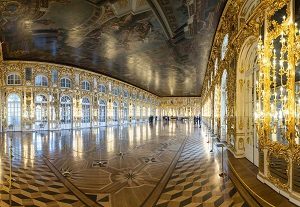
Amber Room
It is a reconstructed chamber decorated in amber panels backed with gold leaf and mirrors, located in the Catherine’s Palace of Tsarskoye Selo near St.Petersburg. Constructed in the 18th century in Prussia, the original Amber Room was dismantled and eventually disappeared during World War II. Before its loss, it was considered an “Eighth Wonder of the World”. A reconstruction was installed in the Catherine Palace between 1979 and 2003.
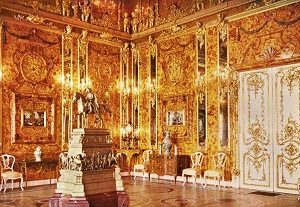
THE HERMITAGE & CATHEDRALS
Day Schedule
➤Breakfast
➤Guided Tour of the Winter Palace and Hermitage
➤City Sightseeing Tour: St. Isaac’s Cathedral, Kazan, the Church of the Spilled Blood
Hermitage Tour
The State Hermitage Museum is often called St. Petersburg’s most important site – a title we think is well deserved. The Winter Palace, the main building of the Hermitage, was home to the Russian Tsars and royal family. There is no better way to understand the heart and soul of St. Petersburg than by roaming the grounds of the Hermitage. Come face to face with history, and the majestic splendour of this unapologetically baroque Palace.
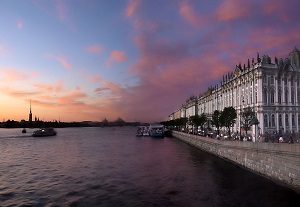
St Isaac’s Cathedral & Kazan Cathedral
After enjoying some traditional Russian food at a stolovaya, or a ‘canteen’, take a short walk past St. Petersburg’s most iconic churches. St Isaac’s Cathedral is one of the world’s largest cathedrals, and its dome is unmissable from any vantage point in St Petersburg. If you’re looking for ornate, this is it.
Surprisingly, St Petersburg is one of the leading gastronomic destinations in Europe. Original and varied, Russian cuisine is famous for exotic soups, which are eaten for lunch. Amongst soups, we should first of all mention “schi” made of sourcrout and “solyanka”, made of assorted meats. Russians are great lovers of pelmeni, small Siberian meat pies boiled in broth.
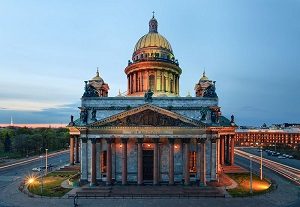
Those are very similar to Italian ravioli but larger in size, more like Chinese dumplings. Mushrooms are one of the most abundant gifts of Russian woods. Those are eaten fried, pickled, salted or boiled. We should also mention “pirozhki” and “bliny” – pancakes, the later became a symbolic Russian food every serious traveler has to try with the caviar.
Construction of beautiful Kazan cathedral commenced at the start of the 19th century, and this neoclassical beauty has stood tall and proud ever since. Often commended as having some of the most beautiful features of any cathedral in the world, the scale of Kazan is something you must experience for yourself.
Day 4
Day Schedule
➤Breakfast
➤Guided Tour of the Winter Palace and Hermitage
➤City Sightseeing Tour: St. Isaac’s Cathedral, Kazan, the Church of the Spilled Blood
Hermitage Tour
The State Hermitage Museum is often called St. Petersburg’s most important site – a title we think is well deserved. The Winter Palace, the main building of the Hermitage, was home to the Russian Tsars and royal family. There is no better way to understand the heart and soul of St. Petersburg than by roaming the grounds of the Hermitage. Come face to face with history, and the majestic splendour of this unapologetically baroque Palace.
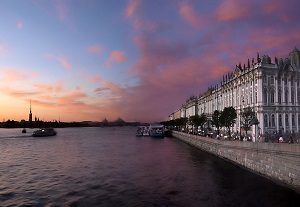
The Church of the Saviour on teh Spilled Blood
Built in the 19th century, the Church of the Saviour on the Spilled Blood is a dramatic feast for the eyes, with an intriguing history. It’s shrouded in mystery and legend, stemming from the assassination attempt on Tsar Alexander II. Designed in the quintessential Russian Orthodox style of extravagant colour and texture, it’s not difficult to see why the Church of the Spilled Blood took 24 years to complete.

During the late Soviet era, the church permanently stood in a falsework. This was lasting for so, so long that finally St. Petersburg residents made an ironic belief that as soon as falsework was removed, the entire USSR would be removed as well. Believe it or not, but the fact is: in 1991 the temple’s falsework was finally taken away and the same year, in August 1991, the end of the Soviet power has come.
St. Petersburg drawbridges’ opening and closing is a magnificent show, spectacular and captivating. What’s interesting it’s not a tourist attraction, but a purely technological procedure, the fact which adds flavor to the experience. St Petersburg has 9 out of 10 world’s big bridges that are lifted regularly. The remainin one is the London’s Tower bridge. Optional midnight drawing bridges cruise is seasonally available, please inquire.
Day 5
PETERHOF PALACE & FABERGE
Day Schedule
➤Breakfast
➤Guided tour to the royal Peterhof Palace
➤Guided tour to the Peter and Paul Fortress and Cathedral
➤Faberge Museum Tour
➤Boat cruise
➤The evening is free at leisure
Gardens and parks are spread over more than four hundred hectares and include thirty-one amazing museums and beautiful Versailles-style gardens. Interiors, as always in Russia, are all made of gold. In summer, the Peterhof is especially good thanks to its famous fountains which run naturally.
We shall visit the Grand Palace – the golden must-see! – and have a tour around the estate. Facing the Gulf of Finland, the palace – rises above the Grand Cascade and the Lower Park, stretching along the upper terrace for almost three hundred yards. The original idea for the location and general appearance of the “Upper Chambers” — as the Grand Palace was first known — belonged to Peter the Great. Throughout the XVIIIth and XIXth centuries, the finest Russian and West European architects worked on the facades and the interior decor. But the greatest contribution was made by Bartolomeo Francesco Rastrelli, who transformed the Grand Palace into a masterpiece of Baroque art during the reign of Peter’s illustrious daughter, Empress Elizabeth, in the eighteenth century.
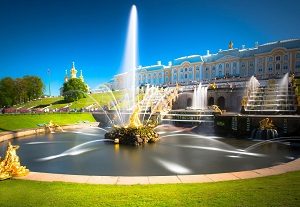
The Peter and Paul Fortress
The Peter and Paul Fortress and Cathedral are the first and oldest landmark in St. Petersburg, built between 1712 and 1733 on Hare Island along the Neva River. Both the cathedral and the fortress were originally built under Peter the Great and designed by Domenico Trezzini. The cathedral’s bell tower is the world’s tallest Orthodox bell tower. Since the belfry is not standalone, but an integral part of the main building, the cathedral is sometimes considered the highest Orthodox Church in the world. There is another Cathedral of Saints Peter and Paul Church in St. Petersburg, located in Petergof.
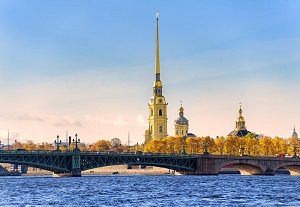
Day 6
ARRIVE MOSCOW
Day Schedule
➤Breakfast
➤Check out of the hotel
➤Transfer to the railway station to board the bullet train for 4 hours journey to Moscow
➤Meet & greet at the train station
➤Transfer to your cosy hotel in the downtown and check-in
➤Evening free at leisure
Day 7
THE KREMLIN & THE CITY
Moscow Tour
➤Breakfast
➤Moscow metro tour
➤Moscow Kremlin tour
➤Walking city tour
➤Free evening on the Arba
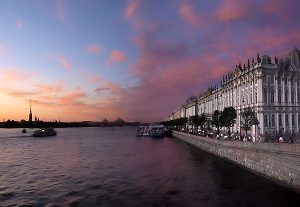
The Moscow Kremlin
The Kremlin’s original purpose was to protect Moscow’s citizens – the very word ‘Kremlin’ translates to ‘fortress inside a city’. As Russia gained power, the Moscow Kremlin gained status as a symbol of power. Today, the Kremlin is a must-see attraction and holds a coveted place on the UNESCO World Heritage List. Representing the pinnacle of Russian power and prowess, the structure’s rich history and physical enormity will amaze you. Enjoy a fully guided tour of the Moscow Kremlin, including the Cathedrals and the Amory, at no additional cost.
St. Basil’s Cathedral
Also known as Pokrovsky Cathedral, this monument is so much more than a church. It was constructed in Red Square to commemorate the capture of Kazan and Astrakhan, a victory that occurred on the Intercession of the Theotokos – a feast day for Russian Orthodox churches. The abundance of feasting is evident in the cathedral’s integral Russian architecture; towering spires, vibrant colours and a mismatch of patterns.
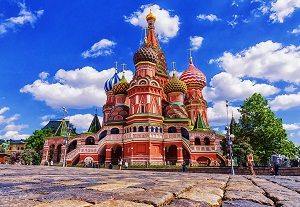
Moscow Metro Tour
The best way to get to know the city of Moscow is by immersing yourself in it – on the train. As the first underground railway system within the Soviet Union, Moscow’s railway system has cultural significance while offering a surefire way to avoid getting stuck in traffic. Opening with 13 stations, the Moscow Metro System now boasts 255 stations, with the majority of the stations and railway lying under Moscow’s streetscape. It’s the busiest metro system in Europe, and a tourist attraction in itself as central stations represent wonderful samples of Soviet architecture and decorative art.
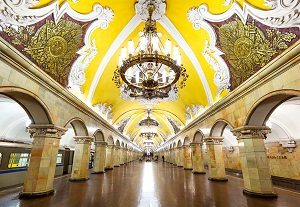
Old Arbat Street is one of the oldest streets in Moscow, and a walk along its old sidewalks is a significant expedition into the past. For centuries, it has attracted artists and creatives who have been inspired by its beatnik attitude. Enjoy an evening of leisure strolling along this famous street, enjoying the gorgeous architecture and artists at work.
Day 8
DISCOVER MOSCOW, PART II
Day Schedule
➤Breakfast
➤Guided tour of the State Tretyakov Gallery
➤Panoramic driving city tour
➤Explore the VDNKh
➤ Guided tour of the Museum of Cosmonautics
The State Tretyakov Gallery
The Tretyakov Gallery is home to some of Russia’s most famous works of art. With an inspiring collection of art as started by Pavel Mikhailovich in the 19th century and an impressive array of exhibitions each year, you’re sure to enjoy your visit. In 1892, Tretyakov presented his already famous collection of approximately 2,000 works (1,362 paintings, 526 drawings, and 9 sculptures) to the Russian nation. The collection now contains more than 130,000 exhibits, ranging from Theotokos of Vladimir and Andrei Rublev’s Trinity to the monumental Composition VII by Wassily Kandinsky and the Black Square by Kazimir Malevich.
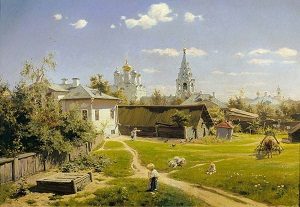
Stalin’s skyscrapers
Stalin left the city of Moscow with a gift of seven ‘sisters’, in the form of seven structurally – and now historically – significant buildings, built between 1947 and 1953. When constructed, the buildings were amongst the tallest in Europe; Moscow State University’s main building held the title of Europe’s tallest building until 1997. It’s difficult to miss these imposing structures in the Moscow skyline – look a little closer, and you’ll notice the unusual combination of Russian baroque, neoclassical, and Soviet Realism architectural influences.
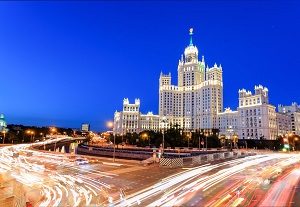
Novodevichy Convent
The Novodevichy Monastery is one of the oldest religious structures in Moscow and has withstood the tumult of war, revolution and international attack. The Convent is part of a larger collection of religious buildings within the Novodevichy Complex. Travel back in time as we explore the Convent and the beautifully-preserved surrounding gardens. The Convent is the UNESCO World Heritage Site.
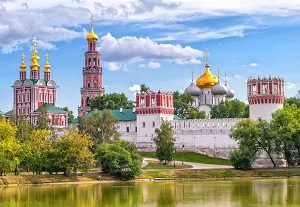
Day 9
IZMAYLOVO, SECRET BUNKER 42 & ROMANOV BOYARS
Day Schedule
➤Breakfast
➤The guided tour to the Izmaylovo Kremlin
➤The guided tour to Exhibition Complex Bunker 42
➤The guided tour to Chambers of the Romanov Boyars
The Izmaylovo Kremlin
As the symbol of the Russian state, the Kremlin in Moscow’s Red Square is famed and celebrated. But there is a second, less known Kremlin in the northeast part of the city. Located near the Serebryano-Vinogradny Pond, the Kremlin in the city’s Izmailovo District is an unexpected, fairytale-like cultural wonderland.
The colourful and bustling complex is home to several single-subject museums. One is dedicated to Russian folk art, another to bread, and yet another to vodka. It includes a wooden replica of the summer palace of Tsar Alexei Mikhailovich, where visitors can experience a traditional Russian meal. It is also home to the Church of St. Nicholas, named after the patron saint of crafts and trade, which at 151 feet in height is the tallest wooden church in the country.

Exhibition Complex Bunker 42
It is a once-secret military complex, bunker, and Spare Long-Range Aviation Command Post (ET-42) in Moscow near the underground Moscow Metro station Taganskaya. It has an area of 7,000 square metres (75,000 sq ft) and is situated at a depth of 65 metres (213 ft) below ground. Construction of the facility began in 1951, in connection with the early threat of nuclear war with the United States. The underground complex was built using the same technique that was used in the construction of the Moscow Metro subway, to which it is connected by two tunnels.
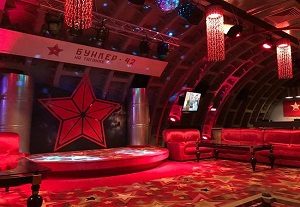
Day 10
KOLOMENSKOYE ESTATE & WOODEN PALACE
Day Schedule
➤Breakfast
➤The guided tour to Kolomenskoye Museum-Reserve
➤The evening is free at leisure
Kolomenskoye Estate
A short ride from the city centre will take you to Kolomenskoe Museum-Reserve, where you can get an idea of what Medieval Moscow looked like. Here you’ll find the oldest garden in Moscow and a favourite estate of Tsar Alexey Mikhailovich, father of Peter the Great.
The Church of the Ascension was built in 1532 on the imperial estate of Kolomenskoye to celebrate the birth of the prince who was to become Tsar Ivan IV (‘the Terrible’). One of the earliest examples of a traditional wooden tent-roofed church on a stone and brick substructure, it had a great influence on the development of Russian ecclesiastical architecture and is now one of Russia’s few
UNESCO WORLD HERITAGE SITES.
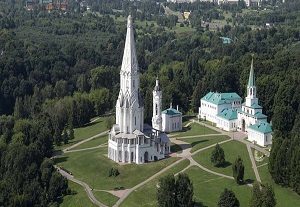
Day 11
DEPARTURE
Enjoy a private transfer to the airport at the time of your choosing. Be sure to stay in touch with Discovery Russia once you’re back home! We love seeing your holiday pictures and hearing your reflections on the trip.
To find out more about this incredible tour, chat to our friendly staff now. Already convinced that you’ll have the time of your life travelling with us? Secure your spot today!


